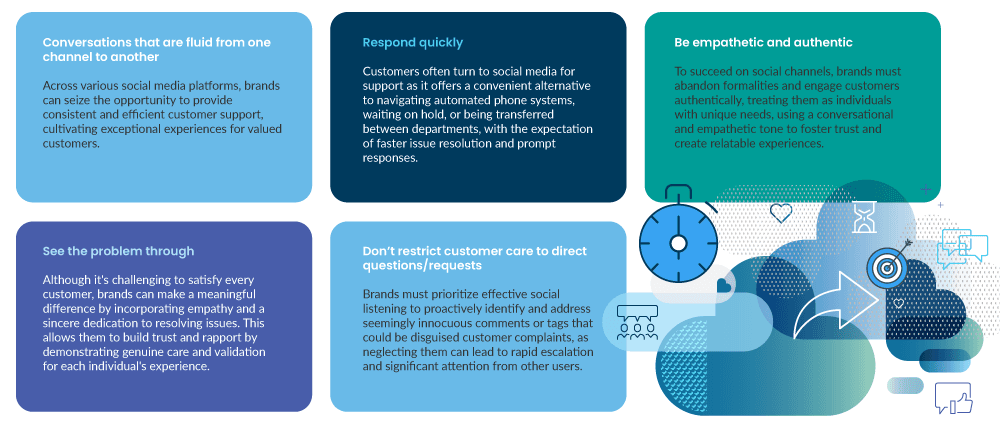Customer expectations have soared to new heights, demanding exceptional care and personalized experiences.
It has become a pivotal touchpoint for brands to connect, engage, and provide support to their customers. In fact, 77% of brands believe customer experience (CX) is a key competitive differentiator, while Emplifi research shows that 56% of consumers sometimes or always abandon purchases due to a single poor customer experience. By meticulously adhering to customer expectations, brands can form authentic connections, build unwavering trust, and create brand advocates who spread their positive experiences wherever they are.
It's absolutely crucial for brands to recognize the immense importance of customer expectations and actively shape their customer care strategies to not just meet, but surpass them. It's all about going that extra mile to give customers an experience they won't forget.
Discover the top five customer expectations that will elevate your brand's connection with your audience and show your unwavering commitment to customer satisfaction.

1. Conversations that are fluid from one channel to another
Whether it's on Facebook, Twitter, Instagram, or any other platform, customers anticipate a consistent level of support. It's in this realm that brands have a golden opportunity to shine.
By implementing a well-oiled process that effortlessly spans all social media platforms, brands can ensure that customers receive effective and efficient support, leaving them with memorable and positive experiences. This approach not only simplifies internal operations, but also helps brands maintain a robust and unified brand image, capable of delivering exceptional service to their valued and loyal customers.
According to a survey, 44% of CX leaders find it challenging to establish a consistent customer experience across various social media platforms. Interestingly, consumers still lean toward making phone calls when given the option, with voice interactions being the most popular choice for communication overall. However, it's worth noting that customer preferences for voice interactions vary significantly based on age demographics. In this same survey, researchers discovered that 52% of baby boomers prefer voice interactions, but only 19% of Gen Z share the same preference.
This generational difference necessitates organizations to adapt their customer engagement strategies to cater to the digital preferences of the younger generation.
2. Respond quickly
Often, customers choose social media for assistance because it allows them to bypass the potential challenges associated with navigating automated phone menus, waiting on hold, or being transferred between different departments.
By reaching out to brands through social media, customers hope to find a quicker resolution to their issues and expect a more immediate response. In fact, Emplifi research shows 52% of consumers expect to receive a response to their questions within an hour, while 32% expect to hear back within 30 minutes. Yet about 20% of consumers report waiting at least 24 hours to receive a response.
Recognizing this inclination, brands should acknowledge and reward their customers' decision to seek assistance through social media platforms. This can be achieved by ensuring a seamless customer care process across socials, where prompt and personalized responses are provided to queries or concerns raised on these platforms.
By acknowledging and catering to customers' preferences, brands can demonstrate their commitment to delivering exceptional service and enhance the overall customer experience. In turn, this fosters a stronger connection with customers, as they feel valued and understood by the brand they’ve chosen to engage with.
It’s also important to note that customers expect different response times for each contact channel; here’s a breakdown of each one.
3. Be empathetic and authentic
Authenticity and genuine connections reign supreme on social channels. It’s crucial for brands to let go of the formalities of "brand speak" and communicate with customers as humans rather than faceless entities. In fact, a November 2021 survey by Harris Interactive commissioned by Emplifi, less than half of all consumers surveyed feel they receive high levels of empathy when interacting with brands,
Customers seek a more personal and relatable experience when engaging with brands on social media, and they expect to be treated as individuals with unique needs and concerns. This means adopting a conversational and empathetic tone that resonates with customers and fosters a sense of trust and understanding.
Use language that’s easy to understand, expressing empathy about customers' issues, and offering clear and concise solutions. By doing so, brands can cultivate an approachable atmosphere, show they genuinely care about their customers' well-being, and are committed to helping them in a friendly and supportive manner.
4. See the problem through
While it's impossible to please every customer, brands can still make a significant impact by infusing their customer care interactions with empathy and a genuine commitment to finding a satisfactory resolution. Empathy plays a crucial role in understanding customers' frustrations, challenges, and emotions.
When brands approach customer issues with empathy, they demonstrate that they truly care about the individual's experience and are willing to listen and understand their concerns. By acknowledging customers' feelings and validating their experiences, brands create a sense of trust and rapport.
In situations where finding a perfect solution may not be feasible, it’s important for brands to go the extra mile in providing some level of satisfaction. As a matter of fact, in the same survey by Harris Interactive, 62% of consumers don't believe they currently receive excellent CX on social media when they're making purchases. Providing a high level of service not only helps in managing customer expectations, but it also preserves the relationship by ensuring customers feel heard and respected. Even if a problem cannot be completely resolved, customers appreciate brands that demonstrate a genuine commitment to finding a satisfactory outcome.
5. Don’t restrict customer care to direct questions and requests
Effective social listening is paramount for brands to identify and address customer complaints that might initially appear as innocuous comments or tags. It's crucial to recognize that a seemingly harmless mention or tag can actually be a disguised customer complaint, which, if left unattended, can quickly escalate and attract significant attention from other users.
When a customer makes a complaint, no matter how subtle, brands need to respond in a timely and appropriate manner. Ignoring or downplaying these disguised complaints can lead to negative publicity, damage brand reputation, and result in a loss of customer trust.
Responding to disguised complaints should be done with tact and empathy. Brands should aim to resolve the issue or offer assistance while maintaining a professional and understanding tone. It's essential to take the conversation private, if necessary, to ensure a more personalized and effective resolution. Engaging in open and transparent communication helps to prevent the escalation of issues and signals to customers that their concerns are genuinely heard and valued, fostering a positive brand image and promoting customer loyalty.
In this particular case, Domino's demonstrated exceptional customer service by promptly addressing a customer's complaint on Twitter. They provided guidance for the customer to direct message their account, ensuring a quick resolution to the issue. Moreover, by personalizing the tweet with the customer's name, Domino's delivered a more individualized and memorable experience.

The takeaway
To stand out from the competition, brands must embrace the power of social customer care and align their strategies with the expectations of their customers. Brands that prioritize customer expectations and deliver exceptional social care experiences will emerge as leaders in their industries, setting themselves apart and establishing a reputation for excellence.

































